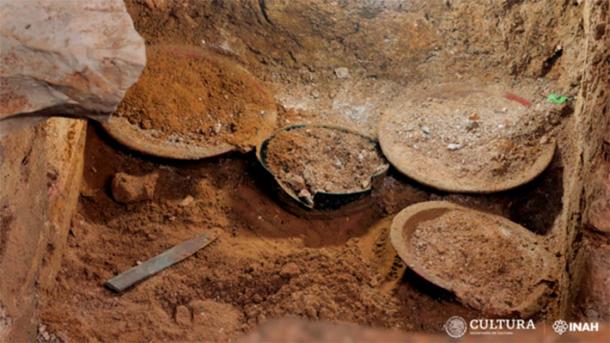
Elite Maya Burial Chamber Uncovered in Palenque Excavation
Archaeologists have made a thrilling discovery at the ancient Maya city of Palenque - a burial chamber of a high-status elite individual within the enigmatic CP3 structure, unveiled during the latest round of excavations. Home of the Red Queen’s Red Palace, Palenque has been the subject of archaeological digs and restoration works for decades.
The complete human skeleton, positioned face-up and oriented northwards, hints at a funerary custom exclusively reserved for the elite. As if that wasn't enough, the excavation also revealed a mysterious niche adorned with an array of green stone figures - adding to the intrigue surrounding the fascinating Maya civilization.

The complete skeleton found at Palenque. (INAH)
Insights into Ancient Maya Provided by Palenque Burial Chamber Discoveries
The Palenque burial chamber contained a primary and secondary burial, with several large ceramic bowls placed inside as offerings. As per Maya funerary customs, these bowls were left within the Palenque burial chamber to nourish the deceased in the afterlife.
- Sieving For Micro-Insights into the Maya Rituals at Palenque Palace
- Unravelling the Mysteries of the Tomb of the Red Queen of Palenque
According to the National Institute of Anthropology and History (INAH) in Mexico, the secondary Palenque burial chamber included an offering consisting of three plates alongside a niche adorned with a collection of enigmatic green stone figures. The skeletal remains from the secondary deposit belonged to a woman who was probably originally buried at a different location, before having her bones placed in the access space or antechamber when it was reopened.
This recent Palenque burial discovery was made during archaeological salvage operations within the CP3 structure, which is currently undergoing infrastructure improvements and renewal as part of the Program for the Improvement of Archaeological Zones (Promeza). The INAH, operating under the auspices of the Mexican Ministry of Culture, is responsible for carrying out the Promeza initiative.

The Palenque burial chamber excavations also revealed a mysterious niche adorned with an array of green stone figures. (INAH)
Restoring Palenque: Excavations Reveal New Details About Maya History
Diego Prieto Hernández, the general director of the INAH, shared the latest updates on the institution's collaborative fieldwork with the National Fund for the Promotion of Tourism. The ongoing work is being carried out in Section 1, spanning from Palenque, in Chiapas, to Escárcega, Campeche.
“In Palenque, important work is being done to condition the area, since a growing number of visitors is expected to exceed 500,000 visitors a year,” explained Prieto Hernández. “The construction of the Visitor Service Center (Catvi) presents progress from 83 to 87%. Likewise, the rehabilitation of the museum and the renovation of its electrical and plumbing installations are carried out.”
- A Red Palace for the Red Queen at Palenque, Mexico
- Temples of Palenque Reveal Story of Lady Cormorant and Her Three Sons, The Triad Gods
According to the report, the archaeological salvage tasks are almost complete. Nevertheless, archaeologists and other professionals continue with the analysis and interpretation of archaeological information being unearthed in the area.

Excavations of the Palenque burial chambers revealed several large ceramic bowls placed inside as offerings. (INAH)
As a result of the new information being unearthed during excavations, Palenque Museum is in the process of updating its scientific script, and new signage for the archaeological zone is currently being prepared. Additionally, infrastructure is being developed to support merchants and artisans selling their products to the public. Heritage Daily reported that the rehabilitation of walkways in various sectors of the archaeological site, including the newly opened Group IV, is also underway.
Digs taking place at Palenque are just part of several ongoing archaeological projects in Mexico. INAH announced that as of March 20, 2023, they have recovered 2,655 real estate assets, 218 movable goods (such as ceramics or figurines), 255,683 ceramic fragments currently being analyzed, 177 human burials and 38 natural features associated with the landscape.

Ruins of the ancient Maya city of Palenque, where the recent Palenque burial chambers were discovered by archaeologists during excavations ahead of the planned Maya train construction. (Maximilian / Adobe Stock)
Palenque: A Lost Maya Gem
Palenque is an ancient Maya city located in the southern Mexican state of Chiapas, near the border with Guatemala. The city enjoyed its peak during the 7th century AD and it was one of the most important cultural and political centers of the Maya civilization. Palenque is renowned for its magnificent art and architecture, elaborate sculptures and hieroglyphic inscriptions, which reflect the highest heights of the Maya civilization, reported National Geographic.
Palenque was first occupied around 100 BC and flourished during the Late Classic period, from about 600 to 800 AD. During this time, the city was ruled by a series of powerful kings who oversaw the construction of some of Palenque's most famous buildings, including the Temple of the Inscriptions, the aforementioned Red Palace and the Temple of the Cross.
The Temple of the Inscriptions is particularly significant because it contains the tomb of Pakal the Great, one of Palenque's most famous rulers. Pakal's tomb was found deep within the temple, along with a number of remarkable carvings and artifacts that provide insight into Maya beliefs about death and the afterlife. Palenque was abandoned sometime in the 9th century and the city was largely forgotten until the 18th century when explorers rediscovered its ruins.
Top image: INAH announced the discovery Palenque burial chambers. Source: INAH
By Sahir Pandey
References
Barrios, A. G. No date. “Mystery Queen in the Maya Tomb” in National Geographic. Available at: https://www.nationalgeographic.com/history/history-magazine/article/Maya_Red_Queen
Mendez, A. 20 March 2023. “Reportan el hallazgo de una cámara funeraria en Palenque durante trabajos del Tren Maya [They report the discovery of a burial chamber in Palenque during work on the Mayan Train]” in INAH. Available at: https://www.inah.gob.mx/boletines/reportan-el-hallazgo-de-una-camara-funeraria-en-palenque-durante-trabajos-del-tren-maya
Milligan, M. 20 March 2023. “Maya Burial Chamber Containing Green Figurines Found at Palenque” in Heritage Daily. Available at: https://www.heritagedaily.com/2023/03/maya-burial-chamber-containing-green-figurines-found-at-palenque/146600















